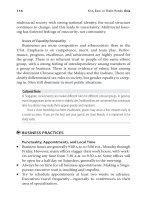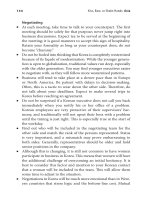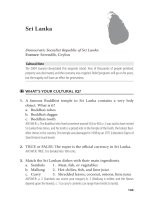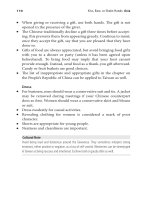How to Attract and Retain More Customers To Your Business pot
Bạn đang xem bản rút gọn của tài liệu. Xem và tải ngay bản đầy đủ của tài liệu tại đây (231.99 KB, 24 trang )
How to Attract and Retain More Customers
To Your Business
Lesson 1 - Attracting Clients To Your Shop/Office
All rights reserved
ISBN: 9781476224893
Author: Peter Adams
How to Attract and Retain More Customers To Your Business
By Peter Adams
Copyright 2012 Peter Adams
Smashwords Edition
Smashwords Edition, License Notes No part of this book (publication) may be reproduced or
transmitted in any form or by any means, mechanical or electronic, including photocopying
and recording, or by information storage and retrieval system without written permission
from the publisher.
Published by Swell Accounting Services. For further information, contact:
Swell Accounting Services,
PO Box 4184,
Elanora, Qld 4221
Telephone - 0452395519
Fax – 61755224593
Financial and Legal Notices Disclaimers
All attempts have been made to verify information provided in this publication and any
attachments, neither the author nor the publisher assumes any responsibility for errors,
omissions or contrary interpretation of the subject matter herein.
The recipient of this publication and any attachments assumes responsibility for the use of
these materials and information. Adherence to all applicable laws and regulations, including
federal, state and local governing bodies, business practices, etc is the sole responsibility of
the recipient.
INDEX
Welcome
Introduction
Problem Areas for Not Attracting Clients
Step 1 What can you do for your Customers?
Step 2 Identify your Customer
Step 3 What do your Customers want?
Step 4 Are you better than your competitors?
Step 5 Develop your USP
Step 6 Networking
Step 7 Removing your Customer’s Fear or Perceived Risk
Step 8 Cross Promotion
Step 9 Referrals
Conclusion
WELCOME
Thank you and welcome to our mini series of lessons that will help you with getting more
customers to your business. Our mini course is a 4 part series and will cover the following
topics:
Lesson 1 – Attracting Clients to your Shop or office
Lesson 2 – Attracting more clients via Social Media
Lesson 3 – Call to Action
Lesson 4 – How to Retain Your Customers.
Even though the ideas expressed during the series of the mini course have been tested, some
of these ideas may not be suited or work with your business. The idea of this mini course is to
pass onto you, our valued member, the opportunities for you to gain and retain customers to
your business. It is up to you to determine which ideas you are willing to take, measure this
opportunities. Please note that we have listed only some of the opportunities, not all, that will
work for you.
It is important to keep reviewing these steps regularly so as to attract more customers to your
product or service.
Please have a look on the last page as we have included our special offer to you.
INTRODUCTION
New customers are the lifeblood of most businesses and if you were to ask any business
owner, and they were truthful, their answer would be – they do not have enough of them ….
How do we attract new customers? How do we attract those new customers for a reasonable
cost? And it really can cost less than a postage stamp to contact a potential new customer. If
you know how.
The table below shows the profits earned by retaining your customer. This subject will be
explained in more details in Lesson 4.
The single most important thing you must know before you begin:
To attract a new customer you must understand one very important concept –
customers do not care about you. What they do care about is what you can do for them!
You can spend lots of money on advertising with little return on your investment. In this
lesson, we will show you some ways on how to attract customers to your business without a
lot of cost. If you adopt some of these ideas, keep working on these ideas, we are sure that
you will gain customers.
There are thousands of people out there offering new ways to attract customers. These
include coaches, consultants to advertising companies and advertising sales people or DIY
marketing courses
Equally there are a thousands of ways (or more), of attracting new customers to your business
which are wrong and will waste your hard earned money and time.
Businesses have been told to advertise their product or service using social media such as
Facebook and Twitter. Unless you social media correctly, you will be wasting your time and
money. Our next lesson will cover attracting more clients using social media.
We need to look at new strategies for advertising as the old methods such as Yellow Pages
and Trade Shows are starting to fade. Have you noticed that Yellow Pages and White Pages
advertising are now online? Who wants to fumble through a thick book of telephone names
and addresses to find someone’ telephone number. It is so much better to search online.
When was the last time you went to trade show? Most advertising for trade shows are done
online.
Take a good look at the issues raised in the article below regarding decline in traditional
advertising. This article lists how we are not getting new customers through the traditional
forms of advertising. Hence, we have to look at alternative methods (and keep looking) of
gaining more clients.
The facts are shown below.
(Source - />Statistics on Decline of Traditional Advertising
March 31, 2010 at 3:32 am by Cam
Tags: advertising, marketing
If you are an small to medium sized Australian business it may be time to think about how
you spend your advertising dollars.
Why, well the statistics speak for themselves:
Traditional Advertising Channels are Fading
Trade shows: Trade show attendances have decline on average 38% in the last decade, whilst
costs to exhibit have risen 50%. (source: tradeshow magazine)
Yellow Pages: Over 13.4 million Australians did NOT read the Yellow pages last year.
(source: core data research report)
Print: Newspapers advertising has fallen over 28% as people move to other sources to read
the news. (source: Mediapost)
Television: advertising is continuing to fall, with estimates that it will fall over 75% in the
next decade. (source: contact magazine)
Radio: advertising is continuing to fall with a further 15% decline predicted for this year.
(source: mediapost.com)
So what is working?
Well Social Media marketing can certainly be effective as a channel. But we must be weary
on how we do it.
Problem Areas for Not Attracting New Clients
Most people do not want to look at issues and face truths about their business. I was like that
once but I have had to have my opened for me. Otherwise, I was going to be doomed.
There are four possible reasons why you are not attracting customers to your business.
Outlined below are some but not all, of the reasons why you are not able to attract customers
to your business. Let’s have a brief look at what some of these problems are.
Problem Area 1 – Your Investment
Possible reasons:
- Not enough money, time, and effort invested in promoting.
- Promoting in the wrong places with low concentration of potential clients.
- Your message is weak and can’t break through the marketing clutter your prospects are
already exposed to.
Problem Area 2 – Wrong market or customer
Possible reasons:
- Wrong target market
- Wrong or unclear message
- Unclear benefits
- Low believability
- Low credibility
- Wrong offer
Problem Area 3 – Lack of Understanding
Possible reasons:
- Poor sales skills
- Initial risk is too high (credibility)
- Perceived value is too low (believability)
- Service/product is too expensive or too cheap for the target market
Problem Area 4 – Product or Service
Possible reasons:
- Poor quality of product or service
- Poor customer service
- Lack of variety of services and products
- No long-term strategy in place
Now that we have identified the four problem areas, we will look at identifying some of these
issues in our lesson.
Topics to be covered in this lesson are:
Step 1 What can you do for your customers?
Step 2 Identify your Customer
Step 3 What do your customers want?
Step 4 Are you better than your competitors?
Step 5 Develop your USP
Step 6 Networking
Step 7 Removing your Customer’s Fear or Perceived Risk
Step 8 Cross Promotion
Step 9 Referrals
The life cycle of attracting new customers
Let’s have a look at these steps and if you follow these steps, you will increase your customer
base. Be mindful of ensuring that when you are increasing your customer base that these new
customers will be profitable customers. You do not want this (or any) customer to be a
“deadweight” for you. A “deadweight” customer is a customer who keeps hassling you about
cheaper pricing thus reducing your margin, does not pay their bill and is generally a nuisance
to you.
Are you ready for your first lesson? Let’s jump into it.
Step 1- What can you do for your customers?
As mentioned in our introduction “To attract a new customer you must understand one very
important concept – customers do not care about you. What they do care about is what you
can do for them!”
A few steps that we need to do in our business.
1. What is our business? Let’s ask ourselves some basic questions. What products or services
do we offer to our customers? What benefit does our customer get from using our product or
service? Is our customer satisfied with our product or service? Now that we have identified
the answers to these core questions, let’s move onto the step.
2. What do our competitors do? Now that we have answered the core questions above, we
need to understand what our competitors do. This is called Competitor Analysis. Prepare your
own worksheet to write down the information about your competitors. The worksheet is
designed to understand the S.W.O.T analysis, what they do best, which customer they are
targeting and their various price points. Do this exercise, and regularly do this exercise
(perhaps 3 monthly), you will then be well knowledged about your competitors
3. How can we be better? After you have reviewed the two points above, you can then work
out how you can be better. You will need to develop your niche for your product or service or
perhaps you may need to reshape your product or service to meet your niche.
For example, (Service) all law firms in your area and the town concentrate on preparation of
wills and conveyancing. You are a new solicitor to arrive in town which is predominately a
mining town with the demographics being young families. What do you see as a niche to
develop with your business? Answer – commercial law for the mining companies, family law
(hopefully not to be used) for the families in town.
Now let’s look at an example based upon a product. You are new in town (using the same
features of the town and its people above) and looking at setting up a business selling
electrical appliances. You already have two competitors in town – one competitor selling
whitegoods and one competitor selling browngoods. None of these competitors offer
extended warranty on their products just the standard 12 month warranty. How can we be
better?
Answer – we can develop two niches to our customers:
a. We can offer our customers both whitegoods and browngoods in the one shop. How is this
better for the customer?
b. We will offer extended warranty on all of our products (you can consider introductory
offers) so as to give you customers peace of mind for a longer period of time.
Now it is exercise time ……….
Exercise 1 – Thinking about the three points mentioned above, list down:
What is our business?
___________________________________________________________________________
___________________________________________________________________________
___________________________________________________________________________
___________________________________________________________________________
What do our competitors do?
___________________________________________________________________________
___________________________________________________________________________
___________________________________________________________________________
___________________________________________________________________________
___________________________________________________________________________
How can our business be better than our competitors?
___________________________________________________________________________
___________________________________________________________________________
___________________________________________________________________________
Step 2 - Identify your Customer
Our next step now is to identify our customer. What do you know about your customer? Who
are they, what do they do, what are their biggest problems, where can you find them? Start
thinking about a large target market, than narrow it down to your niche market.
We have developed our niche from completing step 1 or you may already have your niche.
Now we have to apply that niche to our customer and our niche market. Some questions that
we need to consider about the type of customer that we are seeking at this step are as follows:
Age,
Sex,
Nationality,
Religion,
Married or single,
Children,
Income,
Tastes,
Desires,
Fears,
Frustrations and many more
These are just some of the factors that you will need to identify and consider about your
customer – current and new customers. Is this the type of customer we want? Answer is
predominately yes, as they are bringing the income into you. However, is this your ideal
customer?
Exercise 2 – Identify your current customer? You may have more than one type of customer
depending on the type of product or service that you are offering. Objective is to identify the
customers to your existing products/services. If you have identified a niche from step 1, set
up your own table in your own format to help you identify your current and new customer by
looking at such factors as Age, Sex, Nationality, Religion, Fears, Income and so forth
Create your own table. After completion of this table you will have a better understanding of
your current customer(s) and your potential customer(s) based upon the products/services or
potential niches that you have identified.
Ideal Customer
Let’s have a look now at an “ideal” customer. We have now identified our customer from
above. Applying the factors from above, how can we best define our ideal customer? Let’s
ask ourselves the following questions.
Who is your ideal customer?
What are the features that apply to our ideal customer?
Are our current customers the ideal customer?
Does your product or service match the wants of our ideal customer?
After you have identified your ideal customer, is your product/service matching the wants of
your “ideal” customer?
You may wish to complete Exercise 2 again now that you have defined your ideal customer.
By knowing who your customers are, you are more able to meet their needs.
Radio stations and television stations conduct regular market research to find out who their
listeners and viewers are and often adapt their programs to suit the audience. Radio stations
particularly have become niche service providers as they specifically aim their product at a
particular group, or niche.
Step 3 - What do your customers want?
Have you considered what your customer wants?
Customers will pay for needs such as electricity, food, clothing, most services but what do
they really want? People have the same basic needs things they must have for survival,
including food, clothing, shelter, and the supplies and equipment necessary to conduct and
manage their lives. Then there are the things people would like to have they want certain
things, and they buy them with money left over after their needs have been met.
Identify what your customer wants………… unless you are in the “Needs” business.
However, customers are cutting back on needs. Your customers may not be buying the $100
pair of shirts but will pay $30 for a shirt (no or little brand loyalty during uncertain economic
times) which may mean they will go to another retail outlet rather than your shop. People
identify the word FREE.
How do you identify what the customer WANTS? I like to do the following strategies to see
what my customers want. Try the out. Please remember to test and measure each strategy.
a. I like to do a Survey to my customers and potential customers. I use a programme called
Survey Monkey whereby I can design my own survey and ask my customers to complete the
survey. I tend to offer my clients something for free in return for their opinion. Go to
www.surveymonkey.com. You can sign up for FREE.
b. Speak to your existing customers. Each customer will have a different want from you.
Perhaps you can tailor make your product or service or develop a niche around their wants so
that you can track new customers.
c. Telephone potential new customers to determine their wants. Are you able to profitable
match their wants.
d. Contact your friends and family to determine their wants.
e. Use Social Media such as Facebook and Twitter. Ask your people that you have as friends
what they want. You could even consider setting up a separate business page on your
Facebook and attract friends.
Exercise 3 – List down the Action Plan that you will now do to identify your customers’
“wants”.
___________________________________________________________________________
___________________________________________________________________________
___________________________________________________________________________
___________________________________________________________________________
___________________________________________________________________________
Exercise 4 – Do you need to fine tune your product/service to meet your wants? If so,
develop your Action Plan plus costing to see if viable.
___________________________________________________________________________
___________________________________________________________________________
___________________________________________________________________________
___________________________________________________________________________
___________________________________________________________________________
___________________________________________________________________________
___________________________________________________________________________
Step 4 - Are you better than your competitors?
You have almost completed the hardest challenges for you to consider with your business.
Keeping ahead of your competition can be tough, especially when staying on top of the day-
to-day issues of your own business takes up so much of your time. However in our slowing
economy, where everyone is vying for the customer’s last dollar, it’s essential to know what
your competitors are up to.
By researching your competitors’ activities, what they’re doing, how they’re doing it and
where their strengths and weaknesses lie, you’ll be able to identify threats to your business
arising from competitors' actions and opportunities for your business to exploit.
Let’s ask ourselves (another brutal question) – are we better than our competitors? In order to
answer to this question we need to do a Competitor Analysis measurement similar to the
example below. If you would like full version of this template, please send us an email to
Once, we have prepared our competitor analysis worksheet, we can look at understanding
how we compare to our competitors and review opportunities for improvement. It is most
important to constantly update your competitor analysis worksheet perhaps every 3 months
minimum. If you can update this worksheet monthly, even better. Your competitors are
always on the move and so should you. You should be the market leader!
Exercise 5 – Prepare your own Customer Analysis Worksheet
Exercise 6 – How can you be better than your competitors? This question can only be
answered once you have prepared your Competitor Analysis worksheet.
___________________________________________________________________________
___________________________________________________________________________
___________________________________________________________________________
___________________________________________________________________________
Step 5 - Develop your USP
What is USP? USP can best be defined as Unique Selling Proposition. A Unique Selling
Proposition (USP) is that special promise you make to your customer that only your business
can offer, which gives you an edge and compels your customer to want to buy from you
rather than someone else.
Once you have defined your Unique Selling Proposition, your goal in everything you do from
now on, in setting up, running, maintaining and developing your business, must be aimed at
achieving this uniqueness.
Every aspect of your business from developing or manufacturing your product or service to
its promotion and delivery must have a unique angle. And not only must it be unique, its
uniqueness must be understood and appreciated by a large enough group of customers (its
market) to make its manufacture worthwhile
Your USP is the cornerstone of your marketing, and without it you can’t compete, nor will
you ever succeed, if you do not have a USP, I suggest you stop everything and find one
now today!
Without a powerful USP you have no positioning, no edge, no reason for customers to buy
from you other than, perhaps, price. This is costing you a fortune in lost profits and lost sales.
Even if you find it hard at first to discover anything unique about what you do or produce,
you must keep searching. If you want to get rich you cannot do what everybody else does.
You must be different, scarce or unique. Becoming different, scarce or unique is the reason
why people will line up to buy what you have, and pay top dollars to get it. So take a fresh
look at yourself. How different, scarce or unique are you?
Sometimes a USP is obvious and quick to reveal itself. You may already be doing something
unique and simply not letting your customers know about it. If this is the case, it's just a
simple matter of starting to tell them what you're doing that will make you unique.
At other times finding a USP can be a difficult, painful and frustrating task. Eventually,
finding a USP may require a whole change in strategy. Your starting point, however, is
always with your customers. Go out and ask them. Get to know what their fears, frustrations,
desires or concerns are, with your company, your industry or your product.
Here is an example of a bad USP and a good USP. Do you see the difference?
Here's an advertisement you might find on any page of your Yellow Pages directory.
For Plumbers
This is the wrong way
Emergency
24 hours-7 days a week
call
0409 904 039
Does this business give you a compelling reason to seek out Joe's services? The obvious
answer is 'No!' Unfortunately, as you can see, this gentleman has not developed a USP.
Perhaps he actually does do something unique in delivering his service, but from his advert
he is certainly keeping it a secret from us.
If Joe was to get to understand his customers their real fears, frustrations, desires and
concerns he would quickly realise that people who have dealt with plumbers, or tradesmen
in general, are mostly concerned and frustrated about their punctuality.
So the question is: why is Joe's advertisement not addressing this frustration?
Here is an example of the right way with a USP.
We Guarantee To Arrive On Time
Or Your Service Call is on us.
Call us on 0409 904 039
Which do you think is the better advertisement? Other USPs that have been developed are:
Video Ezy – “Get it first time or get it free”
Dominos Pizza – “There in 30 minutes or it’s free”
Exercise 7 – Develop your USP for your product or service
___________________________________________________________________________
___________________________________________________________________________
___________________________________________________________________________
___________________________________________________________________________
Step 6 – Networking and Building Alliances
Networking is an ideal opportunity to meet potential new clients. This gives you the
opportunity to mention to the audience about what you can do for other people. Did you see
the last 7 seven words of the previous sentence? These words were “what you can do for
other people”. I did not say anything about me or my business. Your story to your audience
should be about what you can do for them.
Join up to various networking groups in your area. You will find that some networking
groups are free whilst others such as BNI will have a cost to joining them.
Some ideas for networking groups include:
BNI
Chamber of Commerce
Terri Cooper (Gold Coast, Brisbane, Sunshine Coast)
Lions or Rotary Groups
Meetup.com
/> />Exercise 8 - Develop an Action Plan for finding local Networking Groups in your area.
___________________________________________________________________________
___________________________________________________________________________
___________________________________________________________________________
___________________________________________________________________________
___________________________________________________________________________
Building Alliances is an essential part of building your business and attracting more clients to
your business. For example, if your business is bookkeeping, you could consider building an
alliance with an accountant in your area. This will give you an opportunity to tap into the
Accountant’s customer base and vice versa. Refer to our later step on Cross Promotion.
You could also consider building joint ventures with other partners to build a bigger YOU.
Any company that has something you need clients, technology, capabilities is a potential
partner, provided you have something it needs as well. (For an alliance to succeed, both
companies must benefit from it.) But recognize that alliances rarely come without costs. At
the very least, they require an investment of time that you or your key people could be
spending on profitable endeavors. So it pays to be very selective about whom you team up
with.
Exercise 9 – With your business, who could you potentially form an alliance with?
___________________________________________________________________________
___________________________________________________________________________
___________________________________________________________________________
Step 7 - Removing your Customer’s Fear or Perceived Risk
We need to look at two areas – (a) customer’s fear about dealing with your business and (b)
the perceived risk with using your product or service. Once we have identified the issues in
both areas, we can address these issues and retain our clients and attract new clients to your
business.
Ask yourself (or do research by asking your customers or potential customers) what are the:
Fears
Frustrations
Desires
Concerns
our customers have about you, or in dealing with businesses in your industry. By doing this
simple exercise you will be in a position to begin to identify how you can address those
pertinent customer issues, which others in your industry are not addressing?
So if you are a lawyer, for example, one of the fears and frustrations many people have with
lawyers is that they never know what the final cost will be for the issue they hire you “
When you come to XYX Law firm we give you a fixed price for your work, you will know
exactly how much it costs, no matter how long it takes us to finish your work.
This may not make sense to you as a lawyer but I bet if you asked 100 new customers, 99
would say they would like to work with a firm that did this.
Here are some simple and quick ways to help remove your customers'
Perceived risk about your product:
Let them sample or trial your product free of charge
Let them purchase at a low introductory price
Offer them a full, unconditional money-back
Guarantee (or, if you must, a conditional money - back guarantee)
Offer to pay a penalty if you don't perform, such as '110 per cent of your money
back if you're not totally satisfied
Exercise – Putting yourself in your customer’s position for about 30 minutes, list down the
customer’s fears, frustrations, desires and concerns with dealing with your business. You will
need to be honest with yourself. It is like doing a SWOT analysis on your business but from a
customer’s view. Use the table below to complete. Develop your own table to look at the
factors that affect your customer’s experience with dealing with your business.
Exercise – Establish an Action Plan to overcome your Customer’s Perceived Risk of your
product/service. What will you do?
___________________________________________________________________________
___________________________________________________________________________
___________________________________________________________________________
___________________________________________________________________________
___________________________________________________________________________
___________________________________________________________________________
Step 8 - Cross Promotion
What is Cross Promotion? Cross Promoting your business is largely a matter of partnering
with other businesses to create joint advertising, while sharing costs.
Cross promotion is beneficial in many ways. Here are just a few examples:
Broadens your customer base: When two more companies team up, more customers can be
reached. The team effort will broaden your chances of gaining more customers. It allows you
to reach people that you would not have otherwise targeted. Since you are working with
others who are in touch with other groups of people, you have the potential of expanding
your company's market. You get to meet the clients of your business partner - and they in
turn, get to meet yours, so it amounts to being very beneficial to both the parties. Cross
promotion can also be referred to as networking.
Time saving device: Cross promotion amounts to saving time. Since both businesses are
putting in a lot of effort to promote each other and themselves, more people are reached at a
quicker pace. In cross promotion, the workload gets distributed among the two or more
businesses, and thus the people assigned to carry out marketing tasks can finish them in the
assigned time limit.
Money matters: Cross promotion saves quite a bit of money. Both businesses enjoy more
profit, as more income is generated. The expenses and responsibilities are shared between the
businesses. When there is a combination of two or more businesses in marketing, it proves to
be more beneficial. Cost sharing is a major factor that should be taken into consideration.
Money saved is money earned.
Increasing the advertising exposure: As we all know, advertising plays a very important part
in increasing business; and cross promotion enables both businesses involved to gain more
exposure. It is like killing two birds with one stone; each business individually advertises for
both of the businesses.
The Guessing game: Cross promotion can be fun as the customers play a guessing game.
They try to find out who is responsible for advertising as they find them more witty and
unique, and not based on the typical format.
Building trust: Cross promotion facilitates reliability. When another company does your
marketing for you, it has the effect of enhancing your business' reputation and helps to build
trust among customers. It is equivalent to another company putting in a good word for yours.
Stimulates creative thinking: Cross promotion increases creativity. Like the saying "two
heads are better than one", the combined efforts of the creative teams of two companies can
come up with innovative ads, promotional products, and special offers. You can mix and
match them - coming up with exciting, new and effective ways to reach out to new
customers. Creative advertisements are usually very eye-catching and are easy for
prospective customers to remember. They always stand out in the crowd of other
advertisements. Always remember that creativity never goes unnoticed.
If you are struggling to punch up your marketing strategy, consider cross-promotion. Not
only will you be reaching out to new prospective customers that you may not have been able
to reach before, but you will also forge new, effective (and profitable!) business relationships.
That's what marketing is all about!
Cross-promotion has the potential for a big marketing payoff because partners can
successfully expand through each other's customer base. They can gain an inexpensive and
credible introduction to more of their kind of customer more effectively than with the
traditional "solo" methods of networking, advertising, or public relations.
Here are some low-risk and high-opportunity ways to jump-start your first cross-promotion:
Print joint promotional messages on your receipts.
Offer a reduced price, special service, or convenience if customers buy products from you
and your partner.
Hang signs or posters promoting one another on your walls, windows, or products.
Mention one another's benefits when you speak at local events or are interviewed by the
media.
Drop one another's flyers in shopping bags.
Pool mailing lists and send out a joint promotional postcard.
Share inexpensive ads in local shopping papers or a nonprofit event program.
Give a joint interview to local media.
Give your partner's product to your customers when they buy a large quantity of your
product, and ask your partner to do the same.
Use door hangers, posters, flyers, or postcards to promote special offers for each other's
products.
Here are some cross-promotion strategies that can really help your company stand out:
Co-produce special promotions you could not afford by yourself. Hire local community
college broadcasting/cable TV students to produce a "how to use" video and/or audio tape
that involves you and your partner's products.
Have a contest, with the prizes contributed by your partners. For the next contest, roles
change, and you contribute your product or service as a prize for a partner's contest.
Give customers a free product or service from a participating partner when they buy
something that month from all of the partners listed in an ad or on a promotional postcard.
Step 9 - Referrals
You already have some customers. These customers can be a handy tool for you, so let us use
them. You have already been delivering an exceptional product or service to these customers.
Let us now get some feedback from our customers. There are two types of feedback that we
want from the customer:
(a) to see how our service was (you can change this template so that it reflects your product
and
(b) asking for three referrals
If the customer is happy with the product or services that you have given them, the customer
will be happy to give you three referrals. In our business, 95% of our customers have come
from using this form or referrals from building alliances.
As mentioned in Step 6 above, to increase your customer base, you will need to build
alliances and increase your networking opportunities. Once you can demonstrate to your
network and alliance that you offer a great product or service, then you can expand further by
asking for more customers.
Develop your own form to monitor “How Have We Performed?” This template serves two
purposes as mentioned above. At the end of this form include a section for asking for
referrals. This should be easy to collect if you have provided an exceptional service or
product.
Exercise 10 – What will we do now to obtain referrals and feedback? List 3 areas or
customers to whom you will target. Set your own Action Plan.
___________________________________________________________________________
___________________________________________________________________________
___________________________________________________________________________
___________________________________________________________________________
___________________________________________________________________________
___________________________________________________________________________
___________________________________________________________________________
Conclusion
As part of this Mini Course, we have set exercises for you to do. We highly encourage you to
do these exercises so that you can learn how to attract and retain new customers to your
business.
To those business owners doing this Mini Course, we are happy to receive your answers to
each of the Lessons that you participate in. If you would like our initial feedback to your
answers, we will be too happy to do so. Our costs for doing so are as follows:
Lesson 1 – Initial Feedback – Absolutely FREE
Lesson 2 – Course plus Initial Feedback – Normally $97 but to you today, only $47
Lesson 3 – Course plus Initial Feedback – Normally $97 but to you today, only $47
Lesson 4 – Course plus Initial Feedback – Normally $97 but to you today, only $47
Special Offer – If you would like our feedback to all four lessons today, please send
me an email immediately quoting special offer “Mini Course Special Offer 1”, you will
receive our course plus initial feedback for all four lessons for $120.
We offer one-to-one coaching to assist you with gaining and retaining more customers. We
have further templates and systems ready for your use. Just ask us how either by sending us
an email to









